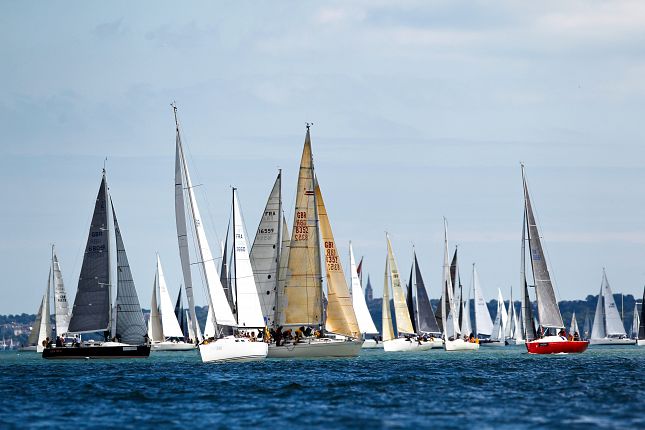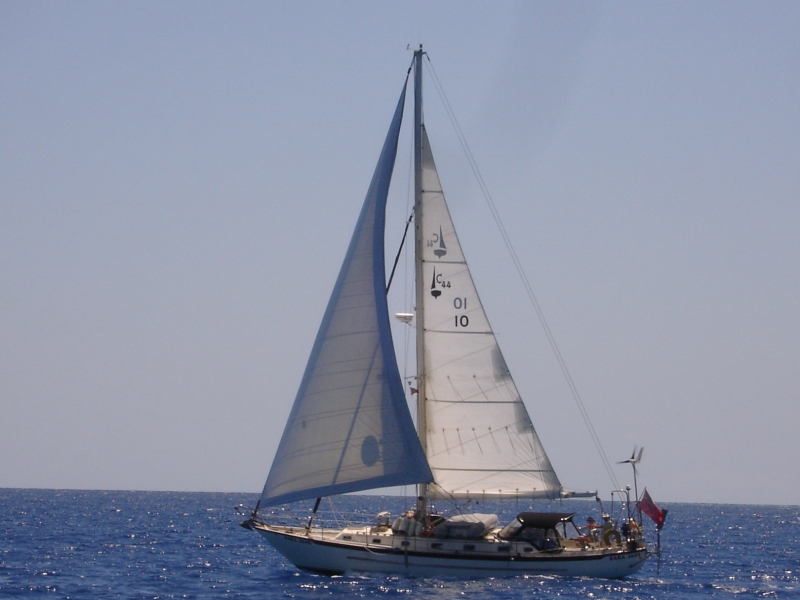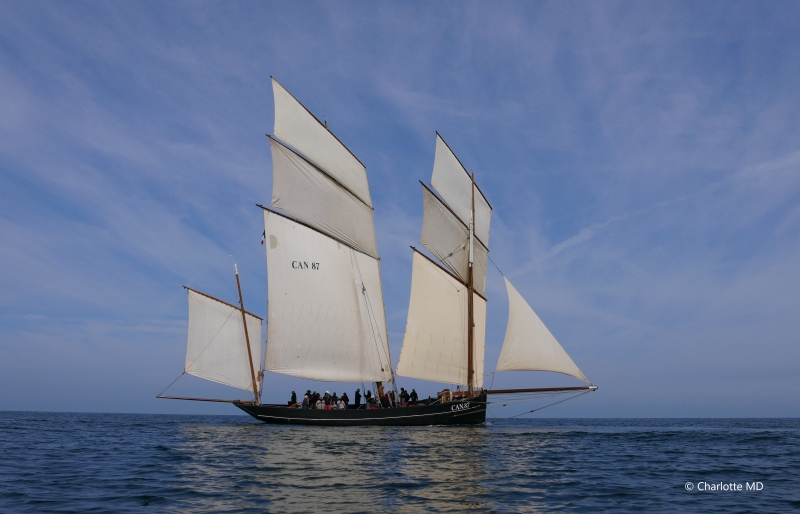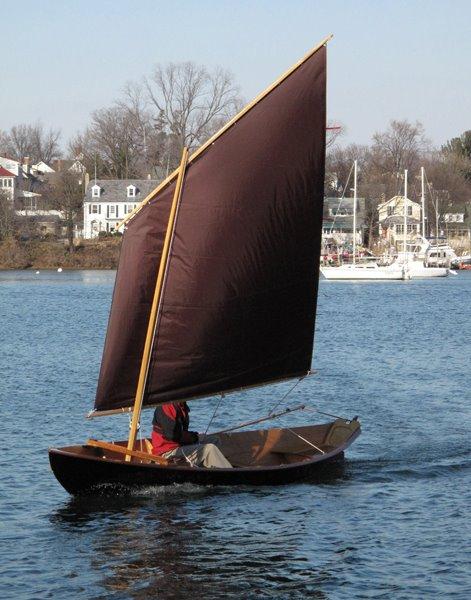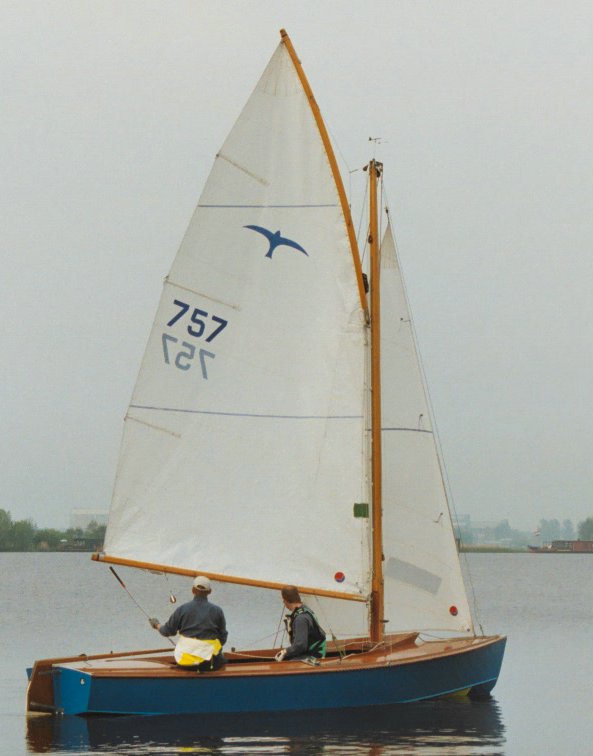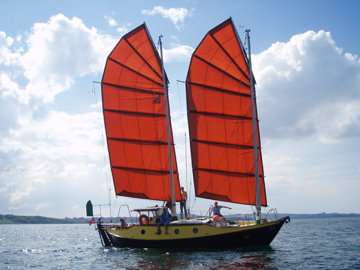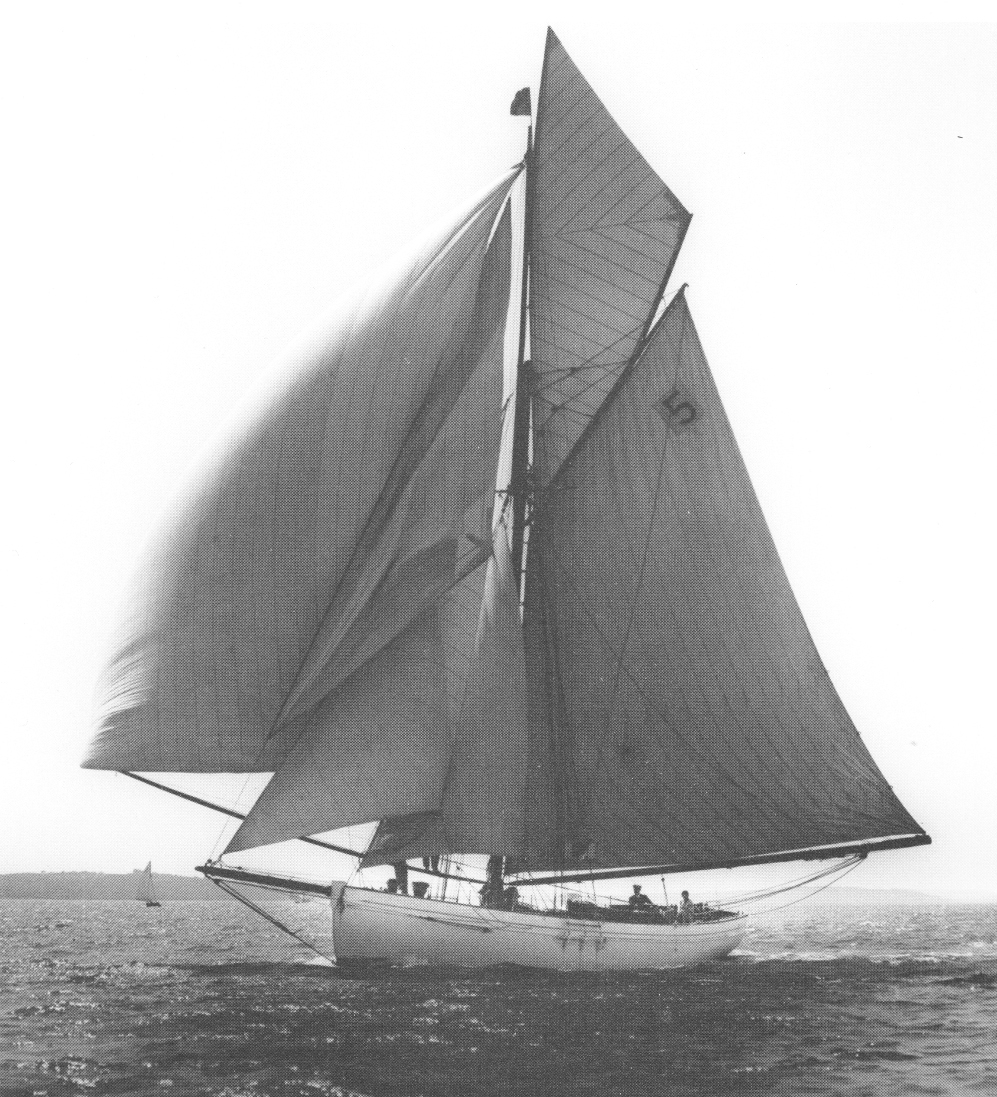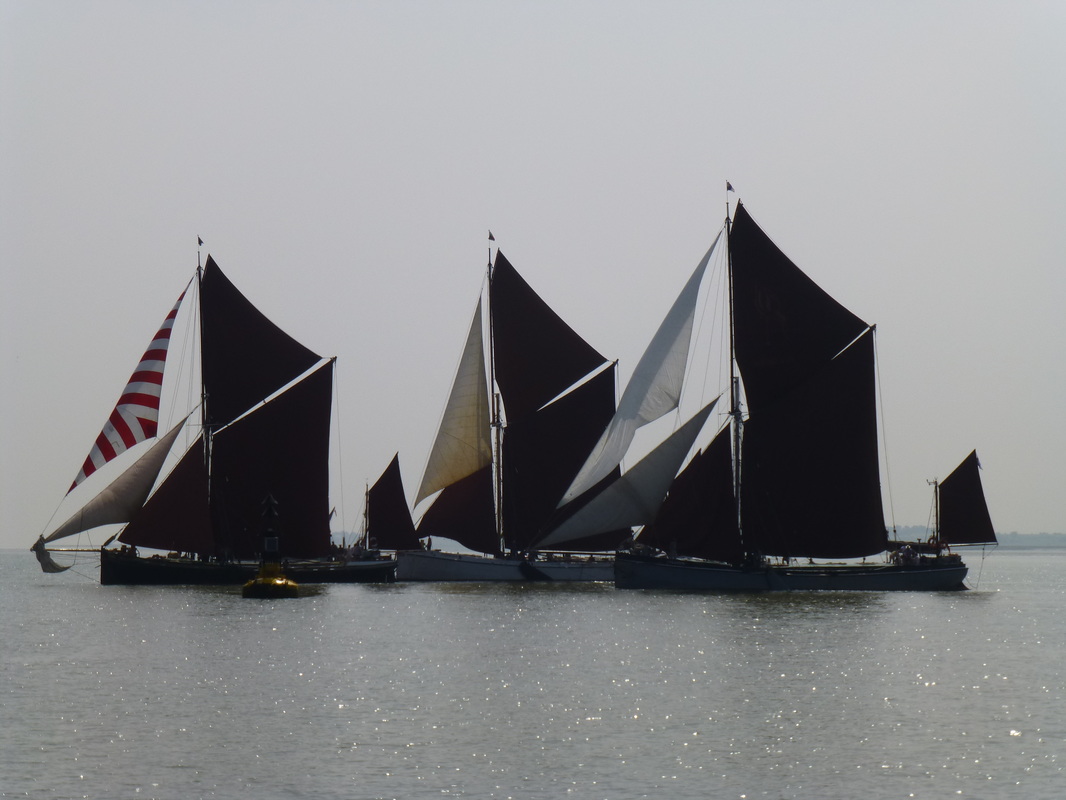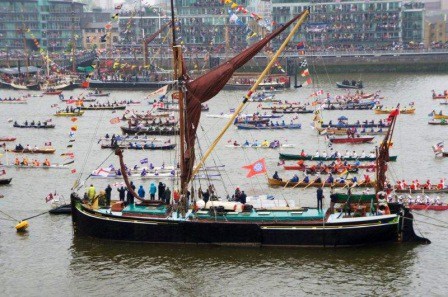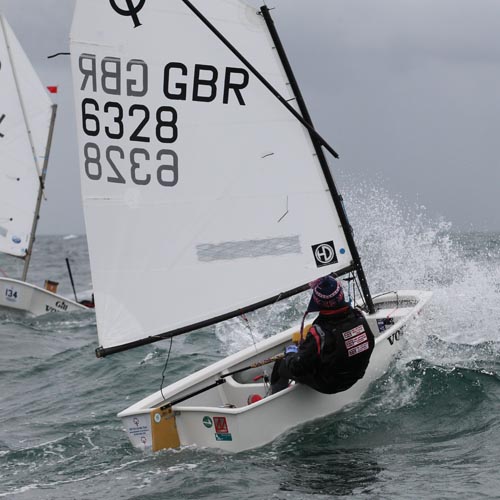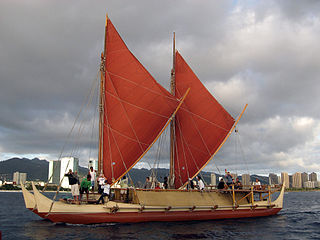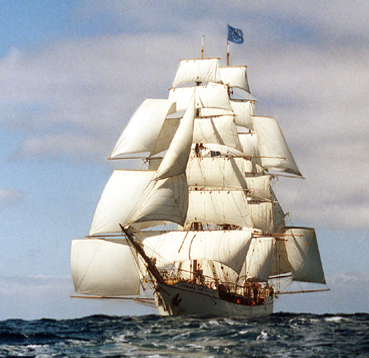On sails and sail plans
There are lots of different types of sails and sail-plans, so...
What is the best sail and what is the best sail-plan?
That question must immediately be followed by the supplementary question...
For What Purpose?
If you look at almost all of the new boats on sale, and at the racing dinghies and yachts, you can be forgiven for thinking that there can be only one choice, the "Bermudian Sloop". One mast, two sails, both approximately triangular.
"Everyone uses it, so it must be the best".
Bernstein's Law applies here: "It ain't necessarily so!"
The photo is from the Round The Island race website.
The Bermudian Mainsail
This particular photo came from Wilkinson Sails, who made some superb traditional sails for me. The photo is of a Bermudian Cutter, which differs from the sloop by having two headsails, the rear one furled (rolled up) in this photograph.
These are usually very tall and narrow "high aspect ratio", which makes them a very efficient shape when working as a "wing". Like a glider, long and slim sails are like long and slim wings, they work extremely well so long as they're working as a wing. But when the wing "stalls", they are quite inefficient. In roughly half of the directions in which we can sail, the "with the wind directions, the Bermudian sail will be stalled. There are ways to manage that, notably "tacking downwind", and/or using a spinnaker (a big, usually colourful, balloon-like sail at the front of the boat).

It's quite important, I think, to understand that the Bermudian righ is a "high tension" arrangement, by which I mean that the wires (usually) keeping that tall mast up where it should be and as strainght as it must be, must be under a very high tension. People realld do sometimes check the tension by striking the wires (called "shrouds" or "stays") and checking the pitch of the sound. High tension means high stress and a greater risk of things breaking in adversity.
There's another name for the rig, which is "Marconi", because to early adopters eyes, the mast with it's multiple stays and "spreaders" looked a bit like a radio mast.
The Lug sails
This is almost the complete opposite of the Bermudian in that most are about as a low-tech as it is possible to get. They're just a square-ish sail supported by two or three sticks and held up and in place with a couple of lengths of rope. Here's my own dinghy:
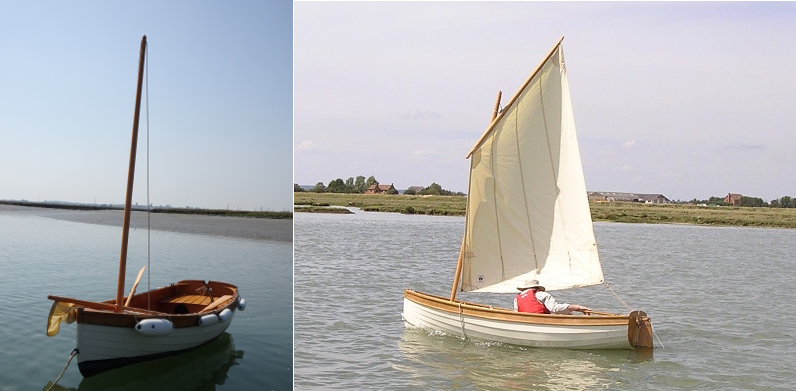
The Lug sail has several minor variants. This one is a "standing lug", where the bottom forward corner of the sail is tied down at the bottom of the mast. With all the lug sails, that spar at the top is held to the top of the mast by a rope used to haul it up there. In this case, that rope just goes through a smooth hole. The standing lug is also, like this one, usually "loose footed", which means that the bottom edge of the sail has no "boom" (stick) to hold it out. All there is is that "sheet" (the rope) that goes between the lower-rear corner of the sail and the downwind corner of the "stern" (back) of the boat. That holds the sail in the right shape and where I want it. No boom means nothing hard to hit my head when I change direction. Notice that the mast has no "shrouds" to keep it up or stiff. It's just a pole and I can easily lift it out when I'm finished for the day.
Notice also that with neither a boom nor shrouds, if I release that sheet, the sail will just go loose and flap in the wind. With shrouds and a boom, the sail would stop swinging when the boom hit the shrouds and, if the wind is at all behind the boat, the boat will keep on sailing even if I didn't want it to. Actually, in that circumstance, most sailing boats should eventually come naturally "head to wind" so that the sails just flap. It just takes a bit longer.
Does it sail to windward as well as a Bermudian? Nope; but it does do perfectly reasonably. And she sails really nicely.
The following photo shows the lugger "Reaper" under sail: (The licensor requests that a donation be made to the en:Scottish Fisheries Museum Boats Club if commercial use is made of this image.)

The rear sail (The "Mizzen") is a standing lug as above, but that forward sail is a "Dipping Lug". It's usually more efficient that the standing lug, but because the forward lower corner of the sail (the "Tack") is attached to the forward end of the boat, if the boat is turned so that the wind comes from the other side, the whole sail usually has to be swapped to the other side of the mast, a task called "dipping". That can be a tricky task, especially on a windy day, though it's easier than you might think as the sail needs lowering only a little and the tack is the tugged down hard to flip the sail to the other side. It's worth noting that most dipping lugs will sail OK with the sail on the "wrong" side, but they don't, of course, sail so well.
Here's a nice video of a dipping lug rigged Shetland 'sixareen' under sail: https://vimeo.com/236663327

It's worth remembering that Lug sails and Gaff sails have been used on working boats for centuries ... there are good reasons for that ... they work very well, they're low stressed, the rigs are vertically compact so less likely to break in bad conditions, they're good value. The fact that, to most peoples' eyes they're pretty, is just an added bonus.
Balanced Lug
On these there is both a "yard" and a "boom", but they both extend a little way forward of the mast. As you can see in the photo bellow (from Chesapeake Light Craft, with the wind on the same side as the sail, the sail shape is less than perfect, but the effect is only modest. In exchange for that, you get a sail that is simple, works well, and can be let out as far as you like to get the angle to the wind right. The sail can swing right round the mast if you want. Some sail either side of the mast also means the sail and boat are well balanced when the wind is from behind the boat. Compare this with the Chinese Lug or Junk sail further down the page.
Michael Storer (https://www.storerboatplans.com/) has a very useful page on lug-rig tips, here: www.storerboatplans.com/design/rig/sails/lug/everything-lug-rig-and-lug-sail/
Arwen's Meanderings, ditto, here: https://arwensmeanderings.blogspot.co.uk/2018/03/setting-up-standing-lug-sail-part-1.html
Gunter Lug
This is a kind of hybrid of several aspects of lug sails. It's main aim is to behave a little more like a Bermudian main sail, whilst retaining the shorter and less stressed mast of the lug. It does achieve both of those things a bit, but it also makes quite a few compromises. Perhaps more compromises than benefits IMHO. Others may disagree. YMMV.
Usually the upper spar, the "gunter" is straight and vertical. The following photo shows a pretty (Dutch, I think) variant with a curved spar, that looks almost like a gaff rig.
The Chinese Lug or "Junk".
I've kept this separate from the other lug sails as, although it's a very close relative, it may have evolve differently and it's use is rather different. I have to say that I think the Chinese Lug might just be the best all-round sail for general use. It's a little less efficient towards the wind than other sails, but it is so handy, flexible and easy to sail, that it deserves to be much more widely used. This is a photo of "Badger" from the website of the Junk Rig Association, where you will find much more information.
The Chinese Lug is a variation of the balanced lugsail, which in the west usually has only two horizontal(ish) spars, the "yard" (upper) and the "boom" (lower). On the Chinese Lug, the sail also has a number of other horizontal "battens" between them, and all of the battens are loosely tied to the mast. That has a number of advantages and a few disadvantages, but perhaps the biggest and most important advantage is when "reefing" or reducing the sail area when it's very windy. On the Junk rig, you just lower the sail a bit and it folds away between each batten. To restore more sail, just haul it up again, usually all done from inside the cockpit. Really easy; really safe. That aspect alone should be enough to consider the Chinese Lug!
Gaff
At first glance Gaff, Lug and Sprit are similar, but the differences are significant. They are all variations of a "fore and aft" four-sided sail, but they differ in how and where the sail is attached to the spars. In the case of the Lug, as above, the sail is attached only to the horizontal spars, though those spars are also tied close to the mast.
In the case of the Gaff sail, the forward end of that top spar and the forward edge of the sail are each fixed or tied close to the mast.
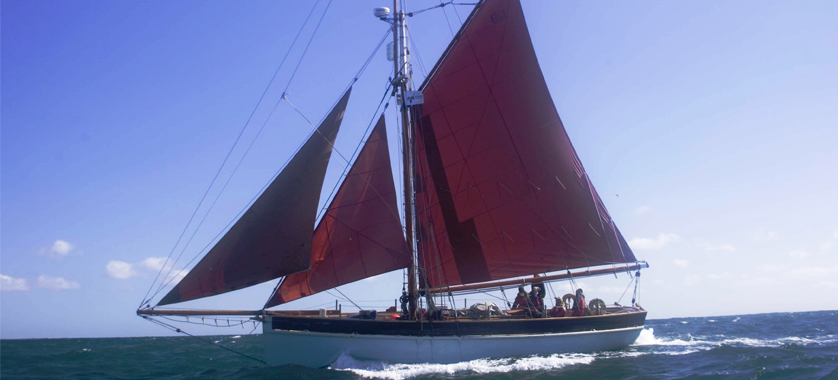
The forward end of the top spar has a two-pronged fork, called the "Gaff Jaws", that fits around the mast, and which slides up the mast when the spar and sail are hauled up. The lower spar normally has a simple universal joint known as a "goose neck" (no, I have no idea why) and the front edge (luff) of the sail is either laced to the mast or held to the mast with hoops, usually of wood, sometimes of metal. Gaff sails are a bit less efficient than Lug sail, but in larger sizes are easier to handle. For that Breton lugger, you need several crew. The (much smaller) boat above can quite easily, with a bit of practice of course, be sailed by just one person.
Notice that that top spar (the Gaff) is held up along it's length by a ziz-zag of rope. The lugger does not need that as the sail keeps the balanced spar in line. The gaff spar isn't balanced, so must be supported by ropes (halyards ... from haul-yards). The lugger has just one halyard. The gaff needs one for the mast end and one to support the rest of the spar. That rear sail, the mizzen, is perhaps a gunter lug, rather than a gaff.
Gaff rigs can carry some additional sails, usually "topsails", which are an upside-down triangle that fills, or more than fills, the gap between the top of the mast and the gaff, and they also usually have more than one headsail ... on the boat above two, often three, sometimes more. They often carry some large light-wind sails, too.
Kasten Marine: Defining The Ideal Sailing Rig
Sprit
Just to confuse us there are actually two completely different sails called "sprit sails". I've added a note at the end about the other sail, where the name applies to it's position on a ship's rig, not the arrangement of the sail itself.
Possibly less efficient at sailing than any of the above rigs (though that "all depends"), but extraordinarily "handy". The place you will most often see these is on the famous Thames Sailing Barges, which for all their size were famously handled by "A man, a boy and a dog". With no engine. It must be said, that sometimes, especially these days, the 'man' is quite often a women and the 'boy' was often a retiree. And whilst we're on the subject, the dog may well have been a cat. We need a picture. This one comes from the website for "Edme".
The "sprit" is a substantial spar that goes all the way from the base of the bast to the very top corner of that big, square-ish, mainsail. Here's a photo from The Barge Trust of "Pudge" at the jubilee in 2012:
Notice that the mainsail is still in place, it's just been squashed-up to the mast. Generally that's done just by hauling one long rope that goes right around the sail and then down to the base of the mast. One person hauling, can take this sail from full and pulling to stowed in a matter of perhaps a minute.
Sprit is again a simple, low-stress rig and it well suits boats from the tiny Optimist (intended for children) right up to those barges. Quite possibly beyond. This photo is from the Optimist Association.
That other "sprit sail"
Is a "square sail" hung below the bowsprit (1) of some earlier "square riggers" as shown below at the bottom right: (Image from here)
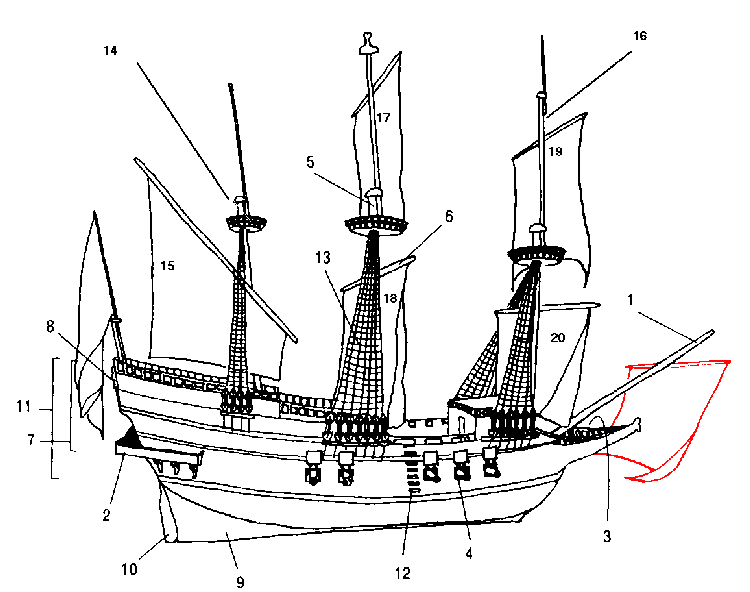

Crab Claw, Lateen and some other Triangular Arrangements.
These are quite varied and mostly unusual, especially in the west, though the various rigs have advantages.
Crab Claw
I've put the "crab claw" first because it seems so different, however it's really only a variety of lug sail. But ... it performs exceptionally well, beating most other sail types on most points of sail. They've very common in the Pacific islands, but rare in the west. Picture and link, Wikipedia.
Lateen (Latin)
These triangular sails also have a lot in common with lug sails and are very likely the early sails from which the gaff sail evolved. They're popular in parts of the Mediterranean and on the Nile, but are neither hugely efficient, nor easy to handle. Look at the ship above showing the "other sprit sail", though, and you'll see an early stage of the evolution from Lateen to Gaff. Photo again from Wikipedia.
"Freedom Rig"
Triangular sails that wrap around the mast and that are tensioned through a wishbone-shaped boom.
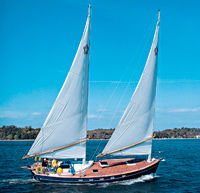
Wishbone Rigs
As the Freedom rig, these use a wishbone boom to tension a triangular sail. They're commonly Ketch or Schooner layout, so for rather large boats. Note though the almost total absence of spars around the area of head height, and that as most sails are triangular and can have roller furling, reefing is pretty easy.

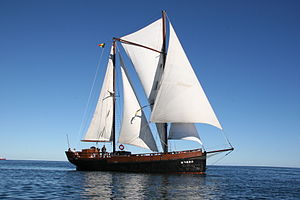
Square Sails
Mostly you will find square sails on sailing ships (tall ships), rather than on the smaller boats most of us sail, but, as I indicate below, if you fancy sailing a tall ship ... follow the relevant links in Sailing Clubs, Schools and Charter on our Links page. It's perfectly feasible to do and you'll have a great time.
It would be silly of me to try to cover here what is a pretty large subject, so I'll just include a few starter links to sailing ships and leave you to explore further.
Wikipedia -- Sailing Ship
Wikipedia -- Sail Plan
Wikipedia -- Viking Longship (They still sail and race these!)
And even the Humber Keel
Small-scale test models of the planned largest Viking ship in modern times "DRAGON HARALD FAIRHAIR"
Sail Plans
Those of us who wish to sail our own boat on our own small budget will probably have a sail-plan with either one or two sails, the former most likely described as a Catboat or a Cat Rig, (not to be confused with a catamaran .. a boat with two hulls side-by-side,) the second most likely a Sloop, mostly because these sail-plans have fewer parts than many others, though a two-masted Lug (western or Junk/Chinese) is also a simple arrangement. Simple sail-plan, fewer parts, lower costs at least where low-stress plans are used (lug, gaff, crab-claw, maybe lateen).
Of course if you make and sail model boats, you have much more flexibility in sails, sail-plans and, erm, accessories: Sailing Ships at Beale Park and RC Sailboat
Those of us who wish to sail on other people's boats could pick nearly any sail-plan they wish, from those above, via pilot cutters, Dutch Barges, Thames Barges and the like, though to the many masted tall-ships. Here's a link to Wikipedia's page on Sail Plans, which covers far more than is sensible here.
I've mentioned elsewhere that if you go to most local sailing clubs and ask nicely, that they will very likely find someone who is happy to take you for a sail. There are many sailing schools who will teach sailing for a reasonable fee (note that these may initially look a bit expensive, but they are usually "all inclusive" of meals and accommodation, as well as the teaching).
If you fancy a tall-ship experience, and I can highly recommend it as it's a brilliant to do, you will find sail-training organisations and charter organisations on the Web.
Have a look on the Links page ... there is a section specifically for Sailing Clubs, Schools and Charter.
National Historic Ships also has a .pdf file of sails and rigs here: http://www.nationalhistoricships.org.uk/data/files/resources/801/Introduction-to-Rigging.pdf
